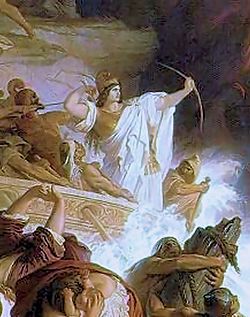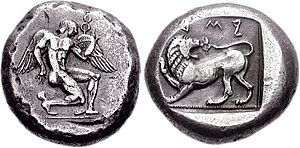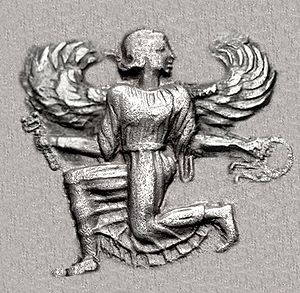Artemisia I of Caria facts for kids
Quick facts for kids Artemisia |
|
|---|---|
| Queen of Halicarnassus, Kos, Nisyros and Kalymnos | |

Artemisia, Queen of Halicarnassus, and commander of the Carian contingent, shooting arrows at the Greeks at the Battle of Salamis. Wilhelm von Kaulbach
|
|
| Reign | c. 480 BC |
| Predecessor | Her husband (name unknown) |
| Successor | Pisindelis |
| Born | 5th century BC Halicarnassus (modern-day Bodrum, Muğla, Turkey) |
| Died | 5th century BC |
| Issue | Pisindelis |
| Greek | Ἀρτεμισία |
| Father | Lygdamis I |
| Mother | Unknown |
| Religion | Greek polytheism |
Artemisia I of Caria (Ancient Greek: Ἀρτεμισία; lived around 480 BC) was a powerful queen. She ruled the ancient Greek city of Halicarnassus and nearby islands like Kos, Nisyros, and Kalymnos. These areas were part of the Persian Empire's region called Caria.
Artemisia was part Carian-Greek from her father, Lygdamis I. Her mother was from the island of Crete. She became an ally of Xerxes I, the King of Persia. She fought alongside him against the independent Greek city-states during the second Persian invasion of Greece.
Artemisia personally led five ships in two big naval battles: the battle of Artemisium and the Battle of Salamis in 480 BC. Most of what we know about her comes from the writings of Herodotus. He was also from Halicarnassus and praised her bravery and how much Xerxes respected her.
Contents
Family and Rule
Artemisia's father was Lygdamis I, who was the ruler (called a satrap) of Halicarnassus. Her mother came from the island of Crete. Artemisia became queen after her husband died. She took over because her son, Pisindelis (Πισίνδηλις), was still too young to rule.
Later, Artemisia's grandson, Lygdamis II (Λύγδαμις Β'), became the ruler of Halicarnassus. This was around the time when the famous historian Herodotus was sent away from the city.
Battle of Salamis
The Battle of Salamis was a major naval battle in September 480 BC. King Xerxes of Persia wanted to attack the Greek fleet. The Greek general Themistocles had sent a message that made Xerxes think it was a good idea to attack right away.
Advice Before the Battle

Before the Battle of Salamis, Xerxes gathered all his naval commanders. He asked them if he should fight a sea battle. All the commanders advised him to fight, except for Artemisia.
According to Herodotus, Artemisia told Xerxes: "Tell the King to save his ships and not fight a naval battle. Our enemies are much stronger than us at sea. Why does he need to risk a sea battle? Athens, which he came to conquer, is already his. No one can stand against him on land."
"If Xerxes doesn't rush into a sea fight, but keeps his ships near the shore, he will win. The Greeks cannot hold out against him for long. They will leave for their cities because they don't have much food on their island. When our army marches towards the Peloponnese, the Greeks from there will worry and leave. But if he hurries to fight, I am afraid our navy will be defeated. This would also weaken our land forces."
"Also, he should remember that some of his allies, like the Egyptians, Cyprians, Kilikians, and Pamphylians, are not very helpful."
Xerxes was happy with her advice and praised her even more. However, he decided to follow the advice of his other commanders. Xerxes believed his men had acted like cowards at the Battle of Artemisium because he wasn't there. This time, he wanted to watch the battle himself to make sure they fought bravely.
During the Battle
Artemisia fought in the Battle of Salamis in September 480 BC as an ally of Persia. She led forces from Halicarnassos, Cos, Nisyros, and Calyndos. She provided five ships for the Persian fleet. Her ships were considered the second best in the entire fleet, after those from Sidon.
Herodotus described her involvement: "Artemisia made me wonder greatly that a woman would go with the army against Greece. Her husband had died, and she had his power and a young son. She joined the army not because she had to, but because she was very brave. Her name was Artemisia; she was the daughter of Lygdamis. Her father's family was from Halicarnassus, and her mother's was Cretan. She led the men of Halicarnassus, Cos, Nisyrus, and Calydnos, providing five ships. Her ships were thought to be the best in the whole fleet after those from Sidon. Of all his allies, she gave the king the best advice."
During the battle, the Persian fleet was losing. An Athenian ship was chasing Artemisia's ship. She couldn't escape because friendly ships were in front of her. She decided to crash into a friendly ship from Calyndos, which was commanded by King Damasithymos (Δαμασίθυμος). The Calyndian ship sank. Herodotus thought Artemisia might have had a disagreement with Damasithymos before.

When the Athenian captain, Ameinias, saw Artemisia's ship attack a Persian ship, he turned away. He thought Artemisia's ship was either Greek or was switching sides to fight for the Greeks. Herodotus believed Ameinias didn't know Artemisia was on the ship. If he had, he would have kept chasing her. The Athenians had offered a prize of ten thousand drachmas to anyone who captured her alive. They thought it was unacceptable for a woman to lead an attack against Athens.
Polyaenus wrote that Artemisia had two different flags on her ship. When she chased a Greek ship, she flew the Persian flag. But when a Greek ship chased her, she flew the Greek flag. This way, the enemy would mistake her for a Greek ship and stop chasing her.
Xerxes was watching the battle from his throne on Mount Aigaleo. He saw Artemisia's ship sink the Calyndian ship. He and others thought she had sunk a Greek ship. One man next to Xerxes said, "Master, see Artemisia, how well she is fighting! She just sank an enemy ship!" Xerxes replied, "My men have become women; and my women, men." No one from the Calyndian ship survived to tell the truth.
After the Battle
After the battle, Xerxes recognized Artemisia as the best officer in his fleet. He sent her a full suit of Greek armor as a gift. He also gave the captain of her ship a distaff and spindle, which were tools for spinning thread.
According to Herodotus, after the defeat, Xerxes asked Artemisia for her advice. He wanted to know if he should lead his troops to the Peloponnese himself or leave Greece and let his general Mardonius take charge. Artemisia advised him to go back to Asia Minor. She supported Mardonius's plan to stay with 300,000 Persian soldiers to defeat the Greeks.
She told Xerxes: "I think you should leave and let Mardonius stay with the soldiers he wants. If he succeeds, the honor will be yours because your servants did it. If he fails, it won't be a big deal because you will be safe. The Greeks will have many problems to survive. Also, if Mardonius suffers a disaster, who would care? He is just your servant, and the Greeks will only have a small victory. As for you, you will go home having achieved your goal, for you have burned Athens."
Xerxes followed her advice. He left Mardonius to continue the war in Greece. Xerxes sent Artemisia to Ephesus to look after his sons who were not born to his main wife.
Views on Artemisia
Herodotus thought highly of Artemisia, even though she supported Persia. He praised her strong decisions and intelligence. He also highlighted how much influence she had on King Xerxes.
Polyaenus also said that Xerxes praised her bravery. He wrote that Artemisia (possibly Artemisia I or Artemisia II) once wanted to conquer a city called Latmus. She hid soldiers near the city. Then, she, along with women, eunuchs, and musicians, held a religious ceremony outside the city. When the people of Latmus came out to watch the grand procession, the hidden soldiers entered the city and captured it.
The historian Justin wrote that Artemisia "was fighting with the greatest bravery among the main leaders. So you might have seen a man showing fear like a woman, and a woman showing courage like a man."
However, Thessalus, a son of Hippocrates, described her as a cowardly pirate in a speech. He said that in 493 BC, the King of Persia demanded tribute from the people of Cos, but they refused. So, he gave the island to Artemisia to destroy. Artemisia led her fleet to the island of Cos to attack the people. However, the gods interfered, and her ships were destroyed by lightning. She then had visions of great heroes and fled Cos. Despite this, she later managed to conquer the island.
Cultural Mentions
Aristophanes, a Greek playwright, mentioned Artemisia in his plays Lysistrata and Thesmophoriazusae.
Pausanias, a Greek traveler and writer, mentioned Artemisia in his book Description of Greece. He wrote that in the marketplace of Sparta, there was a striking building called the Persian Portico. It was built from things taken during the Persian wars. Over time, the Spartans made it bigger and more beautiful. On its pillars were white-marble figures of Persians, including Mardonius and Artemisia.
The ancient encyclopedia called the Suda also mentioned Artemisia.
Artemisia was followed as ruler by her son, Pisindelis. He then became the new leader of Caria. Later, his son, Lygdamis, took over after him.
Images for kids
-
The precious Jar of Xerxes I, found in the ruins of the Mausoleum at Halicarnassus, may have been offered by Xerxes to Artemisia I, who had acted with merit as his only female Admiral during the Second Persian invasion of Greece, and particularly at the Battle of Salamis.
See also
 In Spanish: Artemisia I de Caria para niños
In Spanish: Artemisia I de Caria para niños







